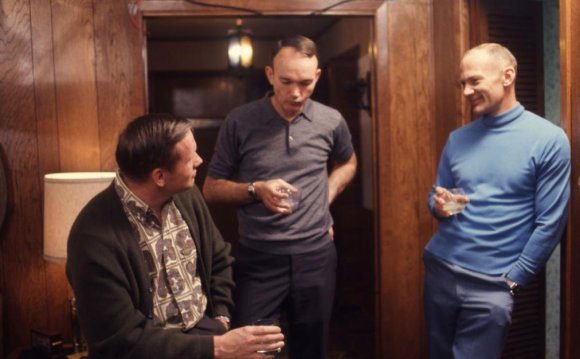
Apollo 11 astronauts Neil Armstrong, Michael Collins, and Buzz Aldrin (NASA)
NASA schedules as the first manned mission to the moon. In January 1969, Neil Armstrong, Edwin "Buzz" Aldrin, and Michael Collins are named as the crew for the historic flight.Neil Armstrong
Born August 5, 1930, in Wapakoneta, Ohio, Neil Armstrong designs model planes as a boy. He gets his pilot's license before his driver's license. In the Korean War, he flies 78 combat missions. Then he becomes a test pilot. After John Glenn orbits Earth, Armstrong says, "Space is the frontier, and that's where I intend to go."
Armstrong's first flight into space is almost his last! In 1966, Armstrong makes a swift recovery from a near-disaster aboard a spacecraft in Earth orbit. The craft splashes down safely. Armstrong has proved that he can handle an emergency situation in space the kind that might arise while trying to land on the moon for the very first time.
Buzz Aldrin
Edwin Aldrin is born in Montclair, New Jersey, on January 20, 1930. His baby sister gives him his nickname she calls him "buzzer" instead of "brother." Aldrin is a top student, and graduates third in his class at West Point. Like Armstrong, he flies combat missions in the Korean War. Afterwards, he goes back to school, to the Massachusetts Institute of Technology (MIT). There, he studies rendezvous how two vehicles can find each other in space.
In 1963, Aldrin becomes the first astronaut to have a Ph.D. The other astronauts call him "Dr. Rendezvous." His math skills come in handy during a spaceflight in 1966. The radar fails, and the computer can't read their location. Aldrin computes the maneuvers himself. The rendezvous is a success. He shows he has the right skills for a complex lunar landing mission.
Michael Collins
Not your typical hotshot pilot, Michael Collins likes to paint, take care of his roses, and read. He doesn't care much for computers. Collins is born in 1930, on October 31 in Rome, Italy. He earns his science degree from the U.S. Military Academy.
Collins is hired by NASA in 1963. In July 1966, Collins and astronaut John Young dock their spacecraft to a booster in space. They ride it to a record altitude of 476 miles. Collins is scheduled for a later moon crew, but in a twist of fate, becomes Command Module pilot for .
RELATED VIDEO












